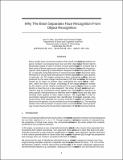Why the brain separates face recognition from object recognition
Author(s)
Leibo, Joel Z.; Mutch, James Vincent; Poggio, Tomaso A.
DownloadPoggio_Why the brain separates.pdf (1.683Mb)
OPEN_ACCESS_POLICY
Open Access Policy
Creative Commons Attribution-Noncommercial-Share Alike
Terms of use
Metadata
Show full item recordAbstract
Many studies have uncovered evidence that visual cortex contains specialized regions involved in processing faces but not other object classes. Recent electrophysiology studies of cells in several of these specialized regions revealed that at least some of these regions are organized in a hierarchical manner with viewpoint-specific cells projecting to downstream viewpoint-invariant identity-specific cells (Freiwald and Tsao 2010). A separate computational line of reasoning leads to the claim that some transformations of visual inputs that preserve viewed object identity are class-specific. In particular, the 2D images evoked by a face undergoing a 3D rotation are not produced by the same image transformation (2D) that would produce the images evoked by an object of another class undergoing the same 3D rotation. However, within the class of faces, knowledge of the image transformation evoked by 3D rotation can be reliably transferred from previously viewed faces to help identify a novel face at a new viewpoint. We show, through computational simulations, that an architecture which applies this method of gaining invariance to class-specific transformations is effective when restricted to faces and fails spectacularly when applied across object classes. We argue here that in order to accomplish viewpoint-invariant face identification from a single example view, visual cortex must separate the circuitry involved in discounting 3D rotations of faces from the generic circuitry involved in processing other objects. The resulting model of the ventral stream of visual cortex is consistent with the recent physiology results showing the hierarchical organization of the face processing network.
Date issued
2011Department
Massachusetts Institute of Technology. Department of Brain and Cognitive Sciences; McGovern Institute for Brain Research at MITJournal
Advances in Neural Information Processing Systems (NIPS)
Publisher
Neural Information Processing Systems Foundation
Citation
Leibo, Joel Z., Jim Mutch, and Tomaso Poggio. "Why the brain separates face recognition from object recognition." Advances in Neural Information Processing Systems 24 (NIPS 2011).
Version: Author's final manuscript
ISSN
1049-5258